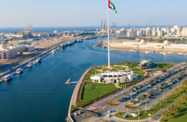Higher levels of investment, coupled with strong performance from both the tourism and real estate sectors, have put Sharjah’s economy on course to expand above nationwide forecasts, with momentum expected to continue into 2018.

Government-led spending to continue stimulating growth
In mid-December the government of Sharjah signalled its intention to continue stimulating economic growth through investment, dedicating a large portion of the 2018 budget to developing key sectors of the economy, including tourism, health care and manufacturing.
Similar to the 2017 budget, the largest portion of spending in 2018 will be allocated to economic development, at 44%, up from 41% in the previous year. An additional 24% will be allocated to infrastructure projects, a 3% increase over 2017.
Sustained public investment is having a positive effect on overall growth. According to ratings agency Standard and Poor’s (S&P), growth is expected to remain stable, at between 2% and 2.5% until 2020, above the World Bank’s 1.4% forecast for the broader UAE in 2017.
In late July the agency affirmed Sharjah’s long- and short-term foreign and local currency sovereign credit ratings of “BBB+/A-2,” with a stable outlook, after slower-than-anticipated fiscal consolidation and increasing levels of debt – driven by efforts to accelerate infrastructure and economic development projects – led the agency to downgrade the emirate’s rating back in January 2017.
However, in its July update, S&P said it was positive about the emirate’s overall fiscal situation. The budget deficit was expected to narrow from 3% of GDP in 2016 to around 1.9% in 2017 on the back of stronger revenue flows, which are expected to increase by around 10% annually through to 2020.
A key factor in strengthening revenues is the introduction of a 5% value-added tax, to be implemented by the UAE and Saudi Arabia in the first quarter of 2018.
Real estate transactions up 46%
Real estate was once again a keystone sector for the emirate’s economy in 2017. The industry saw rising demand in most segments, and a steady flow of new developments fuelled by higher income levels and Sharjah’s growing population.
The number of real estate transactions made in the first half of the year was up 46% on the same period in 2016, according to the Sharjah Real Estate Registration Department. Commercial property transactions jumped 109% year-on-year (y-o-y), outpacing the residential component, which was up 23%.
Momentum remained solid between July and September, with the value of property transactions up 37.2% y-o-y at Dh8.2bn ($2.2bn). The residential segment delivered the strongest performance, accounting for around 60% of transactions, supported by the launch of a number of large-scale projects.
Rising demand for residential units drove up prices in key segments, though this was offset by contractions in other areas, according to real estate firm Cluttons. Rental costs for villas jumped 11.7% in the first six months of 2017 on the back of strong demand and tighter supply, while apartment rentals saw a 7% decline.
Sharjah’s retail sector saw an increase in new offerings, with ground being broken on several developments that will make an additional 278,000 sq metres of prime retail space available by 2020.
Looking ahead, retail is expected to benefit from tourism expansion, supported by the target set by the Sharjah Commerce and Tourism Development Authority’s (SCTDA) to boost visitor numbers to 10m annually by early next decade.
Hospitality industry benefits from higher visitor numbers
The tourism sector, another key economic growth driver, witnessed steady increases in both visitor numbers and revenue in 2017.
The hospitality industry’s earnings rose 7.8% y-o-y in the first six months of the year, with income totalling Dh372m ($101m), according to data issued by the SCTDA.
Higher revenue was fuelled by a 3.5% increase in overnight stays, which totalled 885,000, producing a 70% occupancy rate across Sharjah’s 100-plus hotels.
Increases in arrivals from Asia and Russia should boost the number of 2017 year-end inbound tourists well beyond the 1.8m seen in 2016, building on a trend already evident in that year, when arrivals were up 17% on 2015.
The expansion of air services to the emirate by locally based carrier Air Arabia will also strengthen efforts to attract visitors.
In December Air Arabia announced a second direct flight to Moscow. The new route between Sharjah International Airport and Sheremetyevo International Airport will launch in February 2018.
Air Arabia is also increasing the number of aircraft in its fleet, with a view to augmenting the 130 routes served from its three principal international hubs in Sharjah, Casablanca and Alexandria. The airline plans to add nine aircraft in 2018-19. Additionally, in mid-November it signed a lease agreement for six Airbus 321 long-haul aircraft, a move that will allow the airline to serve destinations farther afield in Asia.


